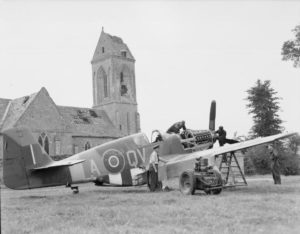Ellon (Calvados)
The cities of Normandy during the 1944 battles
A Mustang III from the 19th Squadron undergoes maintenance at Ellon B-12 Airfield. From left to right: Flying Officer F. H. Price, Leading Aircraftman L. Polley, Corporal J. Hughes, Corporal N. Lee, and Sergeant W. G. Ward.
Photo: IWM CL571
- Liberation: 10 June 1944
- Deployed units:
![]() 2nd Battalion South Wales Borderers Regiment, 56th Infantry Brigade
2nd Battalion South Wales Borderers Regiment, 56th Infantry Brigade
![]() Royal Engineers 16th Airfield Construction Group
Royal Engineers 16th Airfield Construction Group
![]() 122 Wing, 2nd Tactical Air Command
122 Wing, 2nd Tactical Air Command
![]() I/Panzer-Grenadier-Regiment 902, Panzer-Lehr-Division
I/Panzer-Grenadier-Regiment 902, Panzer-Lehr-Division
![]() II/Panzer-Lehr-Regiment 130, Panzer-Lehr-Division
II/Panzer-Lehr-Regiment 130, Panzer-Lehr-Division
- History:
Early in the afternoon of June 9, 1944, the German Panzer-Lehr-Division launched a final attempt to retake Bayeux from the Allies. A battle group led by Prince Wilhelm von Schönburg-Waldenbur, comprising the 2nd Battalion of Panzer-Lehr-Regiment 130 and the 1st Battalion of Panzer-Grenadier-Regiment 902, entered Ellon without encountering any resistance. As they left the village, British tanks belonging to the 56th Infantry Brigade were detected to the northeast. At 5:00 p.m., Generalmajor Fritz Bayerlein ordered an end to the counteroffensive and reorganized the deployment of his forces to protect Tilly-sur-Seulles. The Germans considered that these advanced forces could be surrounded and that it was better to maintain a new defensive line.
The next day at 8:00 a.m., the 56th Infantry Brigade was placed under the command of the 7th Armored Division. Its new mission was to seize the high ground in the Hottot-les-Bagues sector, overlooking the Caen-Saint-Lô road. Beginning at 2:00 p.m., the 2nd Battalion South Wales Borderers Regiment (SWR) moved towards Ellon, securing four bridges over the Aure River until 8:30 p.m. The regiment’s advance was conducted cautiously, as successive terrain compartments limited observation and maneuvering capabilities.
The British feared that enemy elements had remained hidden to guide artillery fire or conduct signaling operations. The 2nd SWR cautiously reached the village of Ellon before nightfall and established a defensive perimeter in this sector. The next morning, the regiment relaunched its attack towards the La Belle Épine crossroads, near Trungy.
The unique terrain of the Ellon region had been identified by the Allies as a potential location for an airfield for their air forces. Thus, on June 29, sappers from the Royal Engineers 16th Airfield Construction Group, under the command of Lieutenant Colonel Leslie Frank Hancock, moved into the village and began work on the future airfield, codenamed “B-12,” the following morning. Between Ellon and the area known as Jerusalem, they installed a 1,700-meter-long runway covered with wire mesh. But on July 12, while traveling to the Maupertus-sur-Mer sector to contribute his expertise to the construction of the “A-15” airfield, Hancock was killed by a mine explosion under his Jeep.
From July 15, when the work was almost finished, the 122nd Wing from the “B-7” airfield near Martragny began its installation at Ellon, starting with the Mustang III fighters of the 19th Squadron. This maneuver did not go unnoticed by the Germans who carried out a major artillery fire: between 3:00 and 4:30 in the morning on July 17, several dozen shells fell on the airfield, killing three members of the unit and destroying five aircraft. After the necessary repairs, the runway was declared operational on July 18. The 122nd Wing operated from the B-12 airfield until September 1: a few days later, on September 4, the land occupied by the airmen was returned to its owners.
Map of Ellon:

